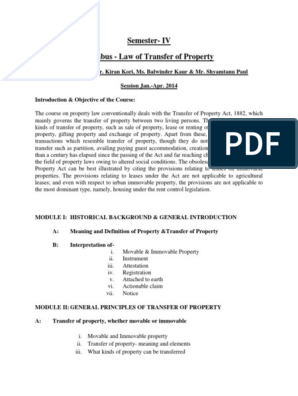0% found this document useful (0 votes)
147 views14 pagesTP - Property Law - July-October 2020
This document provides a teaching plan for a Property Law course being offered at Symbiosis Law School, NOIDA from July 2020 to October 2020. The plan outlines the course objectives, learning outcomes, lecture topics, and assessment activities. Over the course, students will develop knowledge of property law concepts and statutes, and skills in legal analysis, writing, and oral advocacy. Key topics to be covered include the types of property, theories of property evolution, laws regulating transfers and conflicts, and doctrines developed through case law. Lectures will be delivered synchronously and asynchronously, and students must attend at least 75% of sessions to be eligible to appear for examinations.
Uploaded by
VipulaakshCopyright
© © All Rights Reserved
We take content rights seriously. If you suspect this is your content, claim it here.
Available Formats
Download as PDF, TXT or read online on Scribd
0% found this document useful (0 votes)
147 views14 pagesTP - Property Law - July-October 2020
This document provides a teaching plan for a Property Law course being offered at Symbiosis Law School, NOIDA from July 2020 to October 2020. The plan outlines the course objectives, learning outcomes, lecture topics, and assessment activities. Over the course, students will develop knowledge of property law concepts and statutes, and skills in legal analysis, writing, and oral advocacy. Key topics to be covered include the types of property, theories of property evolution, laws regulating transfers and conflicts, and doctrines developed through case law. Lectures will be delivered synchronously and asynchronously, and students must attend at least 75% of sessions to be eligible to appear for examinations.
Uploaded by
VipulaakshCopyright
© © All Rights Reserved
We take content rights seriously. If you suspect this is your content, claim it here.
Available Formats
Download as PDF, TXT or read online on Scribd
/ 14
































































































